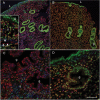Estrogen receptor related beta is expressed in human endometrium throughout the normal menstrual cycle
- PMID: 18775884
- PMCID: PMC2583942
- DOI: 10.1093/humrep/den298
Estrogen receptor related beta is expressed in human endometrium throughout the normal menstrual cycle
Abstract
Background: Estrogen receptor related beta (ERRbeta, ESRRB/NR3B2) is an orphan receptor that shares significant sequence homology with estrogen receptors ERalpha and ERbeta. ERR family members are reported to exhibit constitutive transcriptional activity; however, little is known about the biological function of ERRbeta. In an attempt to delineate its role, we examined expression of ERRbeta in normal human endometrium, a tissue that undergoes cyclic remodelling under the influence of estrogen and progesterone.
Methods: Well-characterized endometrial tissue (n = 31), including full-thickness biopsies, was obtained from women with regular menstrual cycles. RT-PCR was used to measure mRNA encoding ERRbeta, the peroxisome proliferator activated receptor gamma coactivators (PGC)-1alpha and beta and to determine whether ERRbeta splice variant mRNAs were expressed. ERRbeta was immunolocalized using both single and double antibody immunohistochemistry.
Results: Total ERRbeta mRNA appeared higher in proliferative phase samples but results did not reach significance. Transcripts corresponding to the long- and short-splice variants of ERRbeta as well as PGC1alpha and beta were detected but ERRbetaDelta10 was absent. ERRbeta protein was localized to cell nuclei within multiple endometrial cell types including the glands, stroma, endothelium and immune cells, including uterine natural killer (uNK) cells and macrophages. Fluorescent immunohistochemistry revealed that some cells co-expressed ERRbeta and ERalpha or ERbeta, for example, endothelial and uNK cells were ERRbeta+/ERbeta+.
Conclusions: ERRbeta mRNA and protein are expressed in healthy human endometrium. Further studies are warranted to characterize the functional impact of ERRbeta on endometrial biology.
Figures






References
-
- Aranda A, Pascual A. Nuclear hormone receptors and gene expression. Physiol Rev. 2001;81:1269–1304. - PubMed
-
- Barry JB, Giguere V. Epidermal growth factor-induced signaling in breast cancer cells results in selective target gene activation by orphan nuclear receptor estrogen-related receptor alpha. Cancer Res. 2005;65:6120–6129. - PubMed
-
- Critchley HOD, Brenner RM, Henderson TA, Williams K, Nayak NR, Slayden OD, Millar MR, Saunders PTK. Estrogen receptor beta, but not estrogen receptor alpha, is present in the vascular endothelium of the human and nonhuman primate endometrium. J Clin Endocrinol Metab. 2001;86:1370–1378. - PubMed
-
- Critchley HO, Henderson TA, Kelly RW, Scobie GS, Evans LR, Groome NP, Saunders PT. Wild-type estrogen receptor (ERbeta1) and the splice variant (ERbetacx/beta2) are both expressed within the human endometrium throughout the normal menstrual cycle. J Clin Endocrinol Metab. 2002;87:5265–5273. - PubMed
Publication types
MeSH terms
Substances
Grants and funding
- MC_U127685844/MRC_/Medical Research Council/United Kingdom
- G0500047/MRC_/Medical Research Council/United Kingdom
- G0500047(73331)/MRC_/Medical Research Council/United Kingdom
- U1276.00.002.00005.01/MRC_/Medical Research Council/United Kingdom
- U.1276.00.002.00005.01 (85844)/MRC_/Medical Research Council/United Kingdom
LinkOut - more resources
Full Text Sources
Other Literature Sources
Molecular Biology Databases

